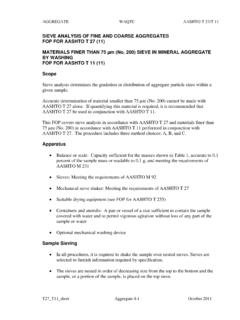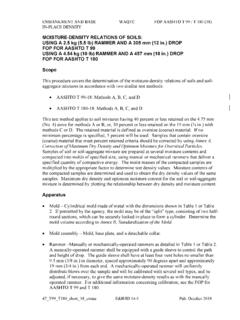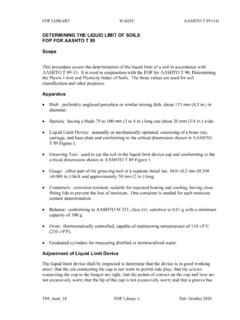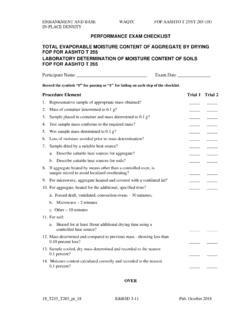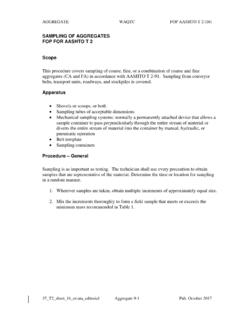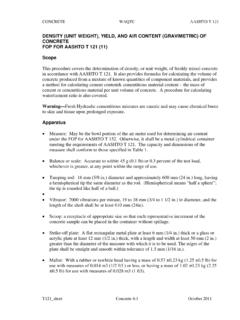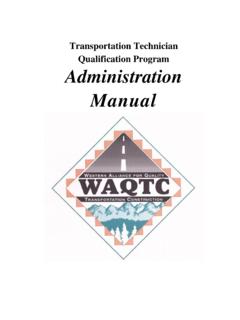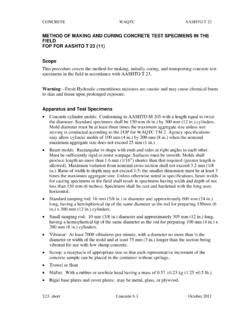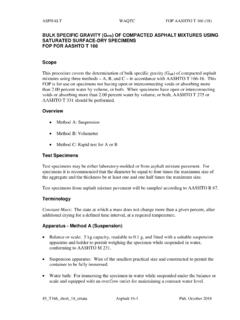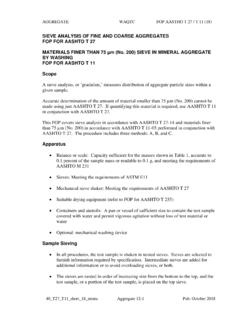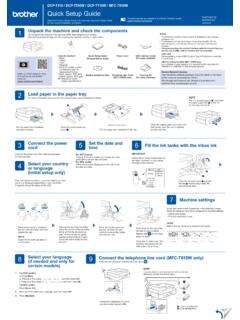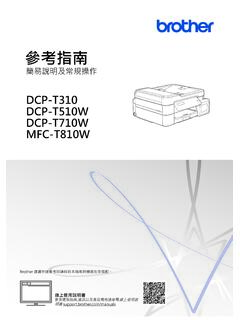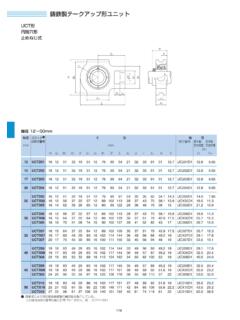Transcription of FOP AASHTO T 310 (20) - WAQTC
1 EMBANKMENT AND BASE WAQTC AASHTO t 310 . IN-PLACE DENSITY. IN-PLACE DENSITY AND MOISTURE CONTENT OF SOIL AND SOIL- AGGREGATE BY NUCLEAR METHODS (SHALLOW DEPTH). FOP FOR AASHTO t 310 (11). Scope This procedure covers the determination of density, moisture content, and relative compaction of soil, aggregate, and soil-aggregate mixes in accordance with AASHTO t 310 . This field operating procedure is derived from AASHTO t 310 . The nuclear moisture- density gauge is used in the direct transmission mode. Apparatus Nuclear density gauge with the factory matched standard reference block.
2 Drive pin, guide/scraper plate, and hammer for testing in direct transmission mode. Transport case for properly shipping and housing the gauge and tools. Instruction manual for the specific make and model of gauge. Radioactive materials information and calibration packet containing: Daily Standard Count Log. Factory and Laboratory Calibration Data Sheet. Leak Test Certificate. Shippers Declaration for Dangerous Goods. Procedure Memo for Storing, Transporting and Handling Nuclear Testing Equipment. Other radioactive materials documentation as required by local regulatory requirements.
3 Sealable containers and utensils for moisture content determinations. Radiation Safety This method does not purport to address all of the safety problems associated with its use. This test method involves potentially hazardous materials. The gauge utilizes radioactive materials that may be hazardous to the health of the user unless proper precautions are taken. Users of this gauge must become familiar with the applicable safety procedures and governmental regulations. All operators will be trained in radiation safety prior to operating nuclear density gauges.
4 Some agencies require the use of personal monitoring devices such as a thermoluminescent dosimeter or film badge. Effective instructions together with routine T310_short E&B/ID 2-1 October 2011. EMBANKMENT AND BASE WAQTC AASHTO t 310 . IN-PLACE DENSITY. safety procedures such as source leak tests, recording and evaluation of personal monitoring device data, etc., are a recommended part of the operation and storage of this gauge. Calibration Calibrate the nuclear gauge as required by the agency. This calibration may be performed by the agency using manufacturer's recommended procedures or by other facilities approved by the agency.
5 Verify or re-establish calibration curves, tables, or equivalent coefficients every 12 months. Standardization 1. Turn the gauge on and allow it to stabilize (approximately 10 to 20 minutes) prior to standardization. Leave the power on during the day's testing. 2. Standardize the nuclear gauge at the construction site at the start of each day's work and as often as deemed necessary by the operator or agency. Daily variations in standard count shall not exceed the daily variations established by the manufacturer of the gauge.
6 If the daily variations are exceeded after repeating the standardization procedure, the gauge should be repaired and/or recalibrated. 3. Record the standard count for both density and moisture in the Daily Standard Count Log. The exact procedure for standard count is listed in the manufacturer's Operator's Manual. Note 1: New standard counts may be necessary more than once a day. See agency requirements. Overview There are two methods for determining in-place density of soil / soil aggregate mixtures. See agency requirements for method selection.
7 Method A Single Direction Method B Two Direction Procedure 1. Select a test location(s) randomly and in accordance with agency requirements. Test sites should be relatively smooth and flat and meet the following conditions: a. At least 10 m (30 ft) away from other sources of radioactivity b. At least 3 m (10 ft) away from large objects c. The test site should be at least 150 mm (6 in.) away from any vertical projection, unless the gauge is corrected for trench wall effect. T310_short E&B/ID 2-2 October 2011. EMBANKMENT AND BASE WAQTC AASHTO t 310 .
8 IN-PLACE DENSITY. 2. Remove all loose and disturbed material, and remove additional material as necessary to expose the top of the material to be tested. 3. Prepare a flat area sufficient in size to accommodate the gauge. Plane the area to a smooth condition so as to obtain maximum contact between the gauge and the material being tested. For Method B, the flat area must be sufficient to permit rotating the gauge 90 or 180 degrees about the source rod. 4. Fill in surface voids beneath the gauge with native fines passing the mm (No.)
9 4). sieve or finer. Smooth the surface with the guide plate or other suitable tool. The depth of the native fines filler should not exceed approximately 3 mm (1/8 in.). 5. Make a hole perpendicular to the prepared surface using the guide plate and drive pin. The hole shall be at least 50 mm (2 in.) deeper than the desired probe depth, and shall be aligned such that insertion of the probe will not cause the gauge to tilt from the plane of the prepared area. Remove the drive pin by pulling straight up and twisting the extraction tool.
10 6. Place the gauge on the prepared surface so the source rod can enter the hole without disturbing loose material. 7. Insert the probe in the hole and lower the source rod to the desired test depth using the handle and trigger mechanism. 8. Seat the gauge firmly by partially rotating it back and forth about the source rod. Ensure the gauge is seated flush against the surface by pressing down on the gauge corners, and making sure that the gauge does not rock. 9. Pull gently on the gauge to bring the side of the source rod nearest to the scaler/detector firmly against the side of the hole.
